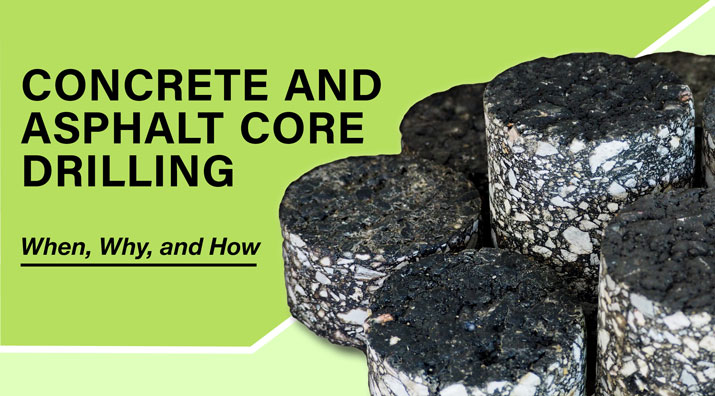
What Is Core Drilling?
Core drilling is a reliable method for the extraction of representative samples from completed asphalt or concrete installations. Drilled cores of the actual construction material provide the best samples for laboratory tests to assess the material quality or verify compliance with project specifications.
Why is Core Sampling Important?
Most core drilling on today’s construction projects is performed to create openings to route utility conduits through a concrete structure. In these cases, the core, the portion of material removed, is discarded as waste material. In the construction material testing industry, however, recovering the core is the objective.
This blog post will focus on the core drilling method and the core sampling equipment. We discuss why and how core samples are taken from asphalt and concrete. Lastly, we touch on some of the different lab tests performed.
Asphalt vs. Concrete: How are the Samples Used
The process of cutting asphalt or concrete cores is similar, but the reasons for sampling each of these materials are substantially different.
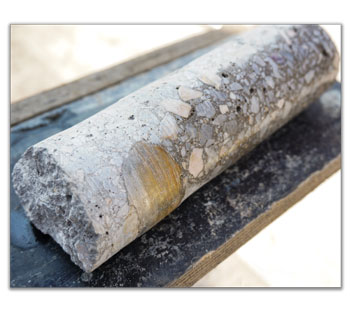
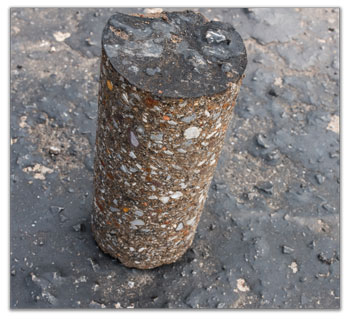
Asphalt Coring
Hot-mix asphalt is batched with mineral aggregates and a specified amount of heated asphalt bitumen. The hot mixture is placed and leveled while still malleable, gaining strength and stiffening as it cools and is densified with rolling compactors. It does not become “hard”; in fact, it is a flexible pavement.
Removing cores from asphalt pavement is a normal part of planned quality control procedures. Project specifications for new pavement installations often factor in design versus actual thickness and density values to determine specification compliance and pay factors. Asphalt core samples are also used for some of the same tests performed on specimens prepared or molded in the laboratory.
The table below lists ASTM / AASHTO asphalt core testing methods:
| Equipment Link by Test Method | ASTM Specification | AASHTO Specification |
|---|---|---|
| Marshall Stability | D5581, D6927 | T 245 |
| Indirect Tensile Strength, IDT (Lottman) | D6931 | — |
| Semi-Circular Bend, SCB | D8044 | T 393 |
| Rice Specific Gravity | D2041 | T 209 |
| Asphalt Wheel Tracking | — | T 324, T 340 |
| Asphalt Content | D2172, D6307 | T 164, T 308 |
| Gradation of Extraction Aggregates | D5444 | T 30 |
| Asphalt Permeability (Florida Method) | — | FM 5-565 |
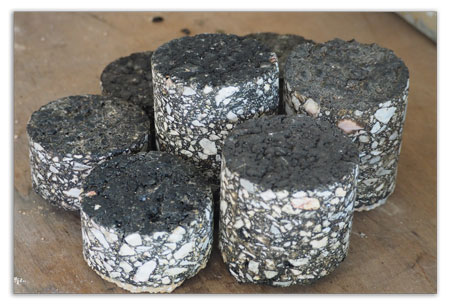
ASTM D5361 and AASHTO R 67 describe standard practices for obtaining cores from compacted asphalt pavements.
Concrete Core Sample Testing
Through gravity, vibration, or forced consolidation, Portland cement concrete is consolidated into its final position while in a plastic state and remains there. It cures over time through the process of hydration and hardens, developing a great deal of compressive strength.
Compressive strength testing of hardened concrete is typically the objective of concrete cores. Sample coring from concrete structures often results from low laboratory strength results from concrete cylinder samples. A core sampling program could be part of the evaluation of an existing structure or when there is a reason to believe quality or strength has been compromised. Other concrete core drilling tests performed include thickness, density, permeability, or petrographic analysis to assess cement content, air content/distribution, or alkali-aggregate reactivity (AAR).
The table below lists selected ASTM / AASHTO concrete core testing methods:
| Equipment Link by Test Method | ASTM Specification | AASHTO Specification |
|---|---|---|
| Compressive Strength | C39 | T 22 |
| Measuring Length of Concrete Cores | C1542 | — |
| Density & Voids of Hardened Concrete | C642 | — |
| Rapid Chloride Permeability | C1202 | T 277 |
| Petrographic Examination | C856 | — |
| Resonant Frequency | D215 | — |
| Electrical Resistivity | Pending | T 358 |
| Ultrasonic Pulse Velocity | C597 | — |
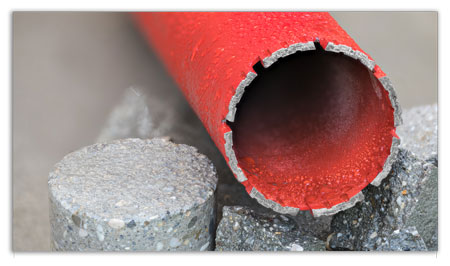
ASTM C42 and AASHTO T 24 describe standard practices for obtaining cores from hardened concrete elements and structures. ASTM C823 guides the planning of the examination and sampling of concrete structures.
Core Sampling Equipment
Safety First
The top priority in planning, locating, and drilling core samples is safety. A smooth, finished surface may conceal conduit, utility lines, or reinforcing steel hidden below. The consequences of drilling through such obstructions range from minor annoyances to catastrophes. Whatever the result, a tragic accident could occur, or the structure may be irreparably damaged.
A preliminary check of existing drawings, discussions with maintenance or design personnel, and alerting the local utility protection service will address many areas of concern. A variety of electronic scanning devices detect potential subsurface problems at varying levels of detail.
- Metal detectors find most types of metals and some other materials that are close to the surface. Their locating precision is not high, and they may not give a good idea of what the obstruction is.
- Rebar locators and concrete cover meters give a clear indication of the location of reinforcing steel and orientation at depths of 7 to 8in (178 to 200mm). Cover meters also determine the depth of the concrete cover and the size of the rebar.
- Ground-penetrating radar (GPR) units optimized for concrete applications provide a 360° rendering of structural elements. Inclusions of all material types are indicated, as well as voids, at depths up to 28in (700mm).
What is the Best Type of Core Drilling Machine
A variety of core drill types are available these days, and some do a great job of making holes in concrete or asphalt materials. Our job is not making holes; it is extracting high-quality, uniform cores for laboratory testing. That criterion requires equipment with enough power and control to turn a coring bit straight and true through difficult materials. A drill motor mounted on a sturdy frame with precision feed, solidly anchored to prevent chatter, wandering, and seizing of the bit, all directly affect sample quality.
We recommend professional electric or gasoline-powered coring machines configured for wet-coring to cool the coring bits and flush away cuttings. The drill motors or transmission heads should be mounted on sturdy frames with carriage systems to maintain alignment and allow even advancement of the bit. The location and type of project dictate optimum core drill selection.
- Electric core drills are set up quickly and operate safely in most environments, even in remote locations, if a portable generator is used. An onboard vacuum system securely anchors the unit to smooth surfaces for stable operation. Anchor bolts can also secure the base for challenging applications.
- Gasoline core drills operate in remote locations with no electrical supplies but cannot be used safely if the environment is indoors or poorly ventilated. The weight of the engine, combined with a large platform, anchors the rig for smooth, stable operation.
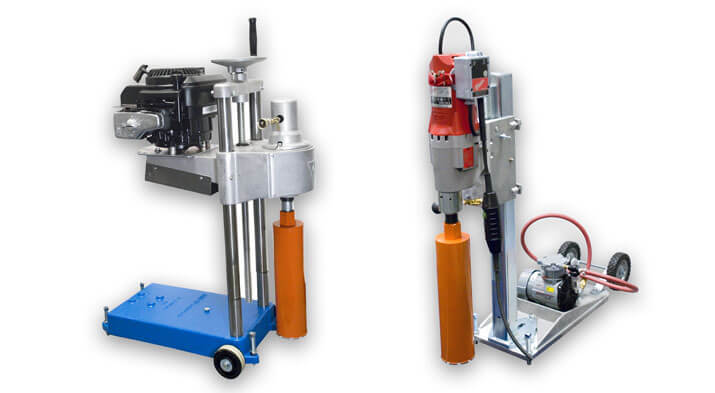
Selecting the Best Coring Bit
Subtle differences in techniques and equipment produce optimum samples of asphalt or concrete materials.
There are two types of coring bits to select from for sampling one-piece closed-head or open-head construction. Closed-head bits attach directly to the threaded drill spindle. Open-head units require a separate expander set to connect to the coring drill spindle. Closed-head bits are more convenient for occasional use, while open-head units are cost-effective for more demanding production applications. Open-head bits also are a better choice to allow easier retrieval of the core specimen.
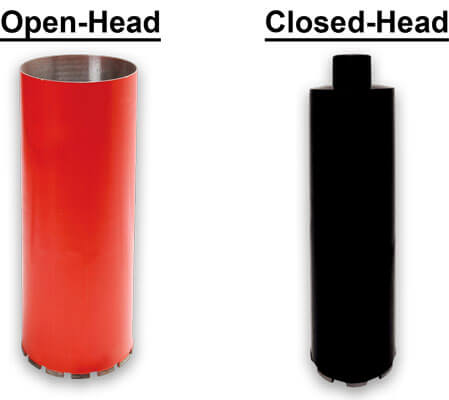
Asphalt pavement presents unique problems when extracting core samples. It is softer than concrete but also more abrasive. The heat from the friction of diamond coring bits makes the bitumen softer and more viscous. As the material softens, it can pinch the diamond bit, stalling the drill and damaging the sample.
For better penetration in softer materials, asphalt-specific core drill bits use a hard bonding material to fix the cutting diamonds in place. When cutting soft material, the diamonds hold their shape longer without fracturing. A hard bonding matrix keeps the expensive diamonds in place while cutting. For environments where the asphalt is already warm, the application of dry ice or other cooling material to the cutting tool or pavement surface minimizes distortion of the sample.
It seems counterintuitive, but concrete coring bits use a softer bonding material to secure the diamonds. When cutting hard, brittle materials, diamonds fracture quickly and have a shorter life. A softer bonding matrix allows them to be carried away when they are no longer effective, exposing new diamonds for faster concrete cutting. To extract high-quality, intact concrete samples, the concrete must be sufficiently cured. Coring during the early, or green, stages of curing is likely to damage the sample.
Embedded reinforcing steel is a significant factor in concrete coring. As noted above, great care must be taken to avoid cutting steel reinforcing bars. A distinct change in the color of the wash water is often an indication that the bit is cutting steel. The friction-generated heat is less of an issue for bit operation with the aggregate and hardened cement materials.
Equipment Accessories
Core drill machine accessories provide additional solutions during the core sampling process.
- Pressurized water tanks provide an easy-to-manage water supply when tap water is too messy or is not available.
- Drilling extension rods extend the depth capacity of the core drill and bit.
Sometimes, the most challenging part of the coring process is retrieving the core sample from the drilled hole. Once secured, the bottom surface is typically rough and jagged, requiring trimming.
- Screwdrivers and wedges used to snap off the core and pry it out of the hole are crude and can damage the core, making it unsuitable for use as a test specimen. Specialized retrieval tongs and extractors ensure an intact sample suitable for laboratory testing.
- Masonry saws with diamond blades are a powerful tool of choice in sample preparation. They are the final step in preparing a core sample for testing. Whether it just means “squaring up” each end of the cylindrical core, cutting flat or longitudinal slices.
We hope this blog post has helped you understand the methods and what core sampling equipment to use for asphalt and concrete.
Gilson Is Here to Help
Contact our testing experts for more information or to discuss your testing application.
Testing Resources
Standard Test Methods, Specifications, and Practices
Individual test methods and specifications referenced in our product descriptions, blog articles, and videos are available for review or purchase from the professional organizations noted.
- ASTM International (American Society for Testing and Materials)
- AASHTO (American Association of State Highway and Transportation Officials)
- ACI (American Concrete Institute)
- State DOTs (Departments of Transportation)
- ISO (International Organization for Standardization)
- BS (British Standards)
- EN (European Standards)

















